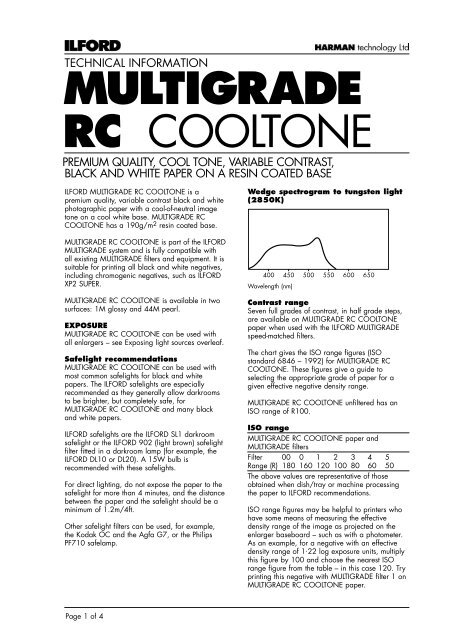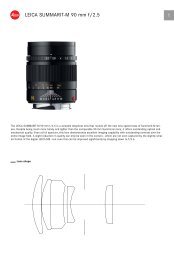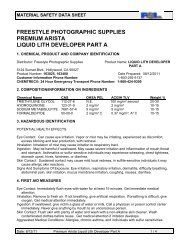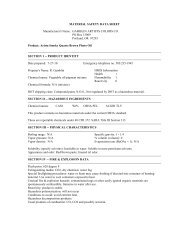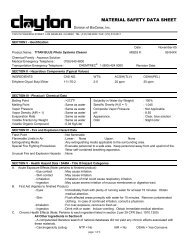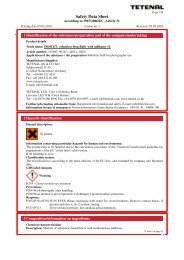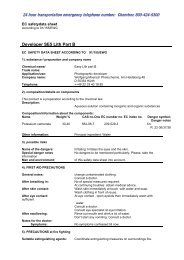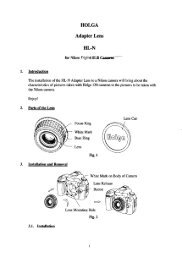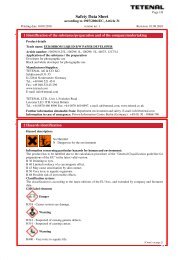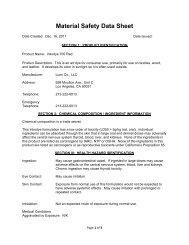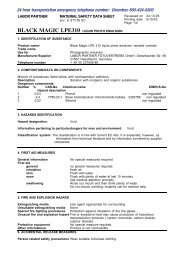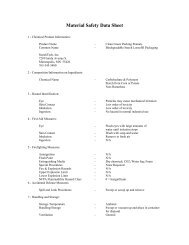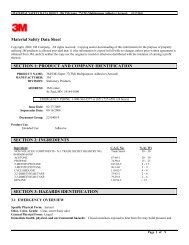multigrade rc cooltone tech info - the ILFORD PHOTO Website
multigrade rc cooltone tech info - the ILFORD PHOTO Website
multigrade rc cooltone tech info - the ILFORD PHOTO Website
Create successful ePaper yourself
Turn your PDF publications into a flip-book with our unique Google optimized e-Paper software.
TECHNICAL INFORMATION<br />
MULTIGRADE<br />
RC COOLTONE<br />
PREMIUM QUALITY, COOL TONE, VARIABLE CONTRAST,<br />
BLACK AND WHITE PAPER ON A RESIN COATED BASE<br />
<strong>ILFORD</strong> MULTIGRADE RC COOLTONE is a<br />
premium quality, variable contrast black and white<br />
photographic paper with a cool-of-neutral image<br />
tone on a cool white base. MULTIGRADE RC<br />
COOLTONE has a 190g/m 2 resin coated base.<br />
MULTIGRADE RC COOLTONE is part of <strong>the</strong> <strong>ILFORD</strong><br />
MULTIGRADE system and is fully compatible with<br />
all existing MULTIGRADE filters and equipment. It is<br />
suitable for printing all black and white negatives,<br />
including chromogenic negatives, such as <strong>ILFORD</strong><br />
XP2 SUPER.<br />
MULTIGRADE RC COOLTONE is available in two<br />
surfaces: 1M glossy and 44M pearl.<br />
EXPOSURE<br />
MULTIGRADE RC COOLTONE can be used with<br />
all enlargers – see Exposing light sou<strong>rc</strong>es overleaf.<br />
Safelight recommendations<br />
MULTIGRADE RC COOLTONE can be used with<br />
most common safelights for black and white<br />
papers. The <strong>ILFORD</strong> safelights are especially<br />
recommended as <strong>the</strong>y generally allow darkrooms<br />
to be brighter, but completely safe, for<br />
MULTIGRADE RC COOLTONE and many black<br />
and white papers.<br />
<strong>ILFORD</strong> safelights are <strong>the</strong> <strong>ILFORD</strong> SL1 darkroom<br />
safelight or <strong>the</strong> <strong>ILFORD</strong> 902 (light brown) safelight<br />
filter fitted in a darkroom lamp (for example, <strong>the</strong><br />
<strong>ILFORD</strong> DL10 or DL20). A 15W bulb is<br />
recommended with <strong>the</strong>se safelights.<br />
For direct lighting, do not expose <strong>the</strong> paper to <strong>the</strong><br />
safelight for more than 4 minutes, and <strong>the</strong> distance<br />
between <strong>the</strong> paper and <strong>the</strong> safelight should be a<br />
minimum of 1.2m/4ft.<br />
O<strong>the</strong>r safelight filters can be used, for example,<br />
<strong>the</strong> Kodak OC and <strong>the</strong> Agfa G7, or <strong>the</strong> Philips<br />
PF710 safelamp.<br />
Page 1 of 4<br />
Wedge spectrogram to tungsten light<br />
(2850K)<br />
Wavelength (nm)<br />
Contrast range<br />
Seven full grades of contrast, in half grade steps,<br />
are available on MULTIGRADE RC COOLTONE<br />
paper when used with <strong>the</strong> <strong>ILFORD</strong> MULTIGRADE<br />
speed-matched filters.<br />
The chart gives <strong>the</strong> ISO range figures (ISO<br />
standard 6846 – 1992) for MULTIGRADE RC<br />
COOLTONE. These figures give a guide to<br />
selecting <strong>the</strong> appropriate grade of paper for a<br />
given effective negative density range.<br />
MULTIGRADE RC COOLTONE unfiltered has an<br />
ISO range of R100.<br />
ISO range<br />
MULTIGRADE RC COOLTONE paper and<br />
MULTIGRADE filters<br />
Filter 00 0 1 2 3 4 5<br />
Range (R) 180 160 120 100 80 60 50<br />
The above values are representative of those<br />
obtained when dish/tray or machine processing<br />
<strong>the</strong> paper to <strong>ILFORD</strong> recommendations.<br />
ISO range figures may be helpful to printers who<br />
have some means of measuring <strong>the</strong> effective<br />
density range of <strong>the</strong> image as projected on <strong>the</strong><br />
enlarger baseboard – such as with a photometer.<br />
As an example, for a negative with an effective<br />
density range of 1 . 22 log exposure units, multiply<br />
this figure by 100 and choose <strong>the</strong> nearest ISO<br />
range figure from <strong>the</strong> table – in this case 120. Try<br />
printing this negative with MULTIGRADE filter 1 on<br />
MULTIGRADE RC COOLTONE paper.
MULTIGRADE RC COOLTONE<br />
ISO speed<br />
The speed of MULTIGRADE RC COOLTONE<br />
depends on <strong>the</strong> filtration used during exposure.<br />
MULTIGRADE RC COOLTONE unfiltered, has a<br />
paper speed of ISO P500.<br />
ISO paper speed<br />
MULTIGRADE RC COOLTONE paper and<br />
MULTIGRADE filters<br />
Filter 00 0 1 2 3 4 5<br />
Speed (P) 200 ---------------------------------- 200 100 100<br />
The above values are representative of those<br />
obtained when dish/tray or machine processing<br />
<strong>the</strong> paper to <strong>ILFORD</strong> recommendations.<br />
Exposing light sou<strong>rc</strong>es<br />
MULTIGRADE RC COOLTONE is designed for use<br />
with ei<strong>the</strong>r a tungsten or tungsten halogen light<br />
sou<strong>rc</strong>e. It is also suitable for use with cold cathode<br />
(cold light) light sou<strong>rc</strong>es designed for variable<br />
contrast papers. O<strong>the</strong>r cold cathode (cold light)<br />
and pulsed xenon light sou<strong>rc</strong>es may give a<br />
reduced contrast range.<br />
Contrast control<br />
Contrast is controlled by using MULTIGRADE hand<br />
filters, <strong>the</strong> MULTIGRADE 600 equipment, o<strong>the</strong>r<br />
MULTIGRADE equipment, variable contrast enlarger<br />
heads or colour enlarger heads.<br />
The twelve MULTIGRADE filters are numbered<br />
00–5 in 1/ 2 steps, with <strong>the</strong> lowest filter number<br />
corresponding to <strong>the</strong> softest contrast. The exposure<br />
time for filters 00–3 1/ 2 is <strong>the</strong> same; that for filters<br />
4–5 is double.<br />
The <strong>ILFORD</strong> MULTIGRADE 600 exposing system<br />
replaces <strong>the</strong> standard lamphouse on <strong>the</strong> most<br />
popular professional enlargers.<br />
Latent image stability<br />
No significant change in picture quality will be<br />
seen when MULTIGRADE RC COOLTONE is left for<br />
a period of 24 hours after exposure and before<br />
processing.<br />
Page 2 of<br />
4<br />
Characteristic curves<br />
Relative log exposure<br />
Relative log exposure<br />
MULTIGRADE RC COOLTONE glossy or pearl<br />
paper exposed through filters 00, 0, 1, 2, 3, 4<br />
and 5. Developer: MULTIGRADE diluted 1+9.<br />
Development: 2 minutes at 20ºC/68ºF.<br />
DISH/TRAY PROCESSING<br />
To achieve <strong>the</strong> coolest image colour, a longer<br />
development time is needed with MULTIGRADE RC<br />
COOLTONE than with o<strong>the</strong>r RC papers. The<br />
remaining processing steps are similar to those for<br />
o<strong>the</strong>r resin coated papers.<br />
Note Photographic chemicals are not hazardous<br />
when used correctly. Always follow <strong>the</strong> health and<br />
safety recommendations on <strong>the</strong> packaging.<br />
Photochemicals material safety data sheets are<br />
available from <strong>ILFORD</strong>. They contain full details for<br />
<strong>the</strong> safe handling, disposal and transportation of<br />
<strong>ILFORD</strong> chemicals.<br />
The image colour of MULTIGRADE RC COOLTONE<br />
can be varied with <strong>the</strong> choice of developer and<br />
<strong>the</strong> processing <strong>tech</strong>nique used.<br />
Density Density
MULTIGRADE RC COOLTONE<br />
Processing summary (intermittent agitation)<br />
<strong>ILFORD</strong> Dilution ºC/ºF Time<br />
chemical (min:sec)<br />
Development<br />
MULTIGRADE 1+9 20/68 2:00<br />
or<br />
MULTIGRADE 1+14 20/68 3:00<br />
or<br />
BROMOPHEN 1+3 20/68 3:00–4:00<br />
or<br />
PQ UNIVERSAL 1+9 20/68 3:00<br />
Stop bath<br />
ILFOSTOP 1+19 18–24/64–75 0:10<br />
or<br />
ILFOSTOP PRO 1+19 18–24/64–75 0:10<br />
Fixation<br />
<strong>ILFORD</strong> RAPID 1+4 18–24/64–75 0:30<br />
FIXER or<br />
HYPAM 1+4 18–24/64–75 0:30<br />
Washing<br />
Fresh, running water – Above 5/41 2:00<br />
Note These longer than usual development times<br />
are needed to obtain <strong>the</strong> coolest image colour.<br />
Development<br />
See <strong>the</strong> ‘Processing summary’ for development<br />
recommendations.<br />
On correctly exposed prints with MULTIGRADE<br />
developer 1+9, <strong>the</strong> image will begin to appear<br />
after about 10 seconds. Overexposed prints<br />
developed for shorter times are acceptable for<br />
those applications where <strong>the</strong> highest quality is not<br />
required. However, full development is needed to<br />
achieve <strong>the</strong> coolest image tone.<br />
To give greater control during development, and<br />
for economy, <strong>the</strong> 1+14 dilution of MULTIGRADE<br />
developer can be used.<br />
MULTIGRADE RC COOLTONE paper can also be<br />
processed in o<strong>the</strong>r high quality dish/tray<br />
developers.<br />
Note The longer development time means that <strong>the</strong><br />
capacity of <strong>the</strong> developer is reduced by half<br />
compared with o<strong>the</strong>r RC papers. For example, up<br />
to 50 20 . 3x25 . 4cm(8x10in) MULTIGRADE RC<br />
COOLTONE prints can be processed in 1l/US<br />
quart of working strength MULTIGRADE developer<br />
at dilution 1+9.<br />
Stop bath<br />
See <strong>the</strong> ‘Processing summary’ for stop bath<br />
recommendations.<br />
The use of a stop bath is strongly recommended. A<br />
stop bath stops development immediately, reduces<br />
<strong>the</strong> risk of staining and extends <strong>the</strong> life of <strong>the</strong> fixer<br />
bath.<br />
Page 3 of 4<br />
Fixation<br />
See <strong>the</strong> ‘Processing summary’ for fixing<br />
recommendations.<br />
The use of a hardening fixer is not recommended<br />
because it reduces washing efficiency. <strong>ILFORD</strong><br />
RAPID FIXER and <strong>ILFORD</strong> HYPAM are<br />
non-hardening fixers.<br />
There is no benefit in extending fixation beyond<br />
<strong>the</strong> recommended time; some loss of print quality<br />
might be seen when long fixing times are given<br />
due to image etching.<br />
Washing<br />
See <strong>the</strong> ‘Processing summary’ for washing<br />
recommendations.<br />
When it is important to obtain a print in <strong>the</strong><br />
shortest possible time, vigorously wash<br />
MULTIGRADE RC COOLTONE paper for 30<br />
seconds in running water.<br />
Prolonged immersion in water can cause edge<br />
penetration and print curl with resin coated<br />
papers: for this reason, avoid total wet times<br />
longer than about 15 minutes.<br />
Drying<br />
A final rinse in <strong>ILFORD</strong> ILFOTOL, diluted 1+200<br />
with water, will aid even and rapid drying.<br />
Optimum quality results will be obtained with <strong>the</strong><br />
<strong>ILFORD</strong> series of dryers, for example, <strong>the</strong> ILFOLAB<br />
1250RC.<br />
When a dryer for resin coated papers is not<br />
available, remove surplus water from <strong>the</strong> prints<br />
and leave <strong>the</strong>m to dry. At room temperature, prints<br />
will dry in 10–20 minutes.<br />
Note MULTIGRADE RC COOLTONE paper, as<br />
with o<strong>the</strong>r resin coated papers, should not be<br />
glazed/ferrotyped or dried on a drum or flatbed<br />
glazer, as this can cause <strong>the</strong> polyethylene in <strong>the</strong><br />
paper to stick to <strong>the</strong> glazing surface.<br />
MACHINE PROCESSING<br />
MULTIGRADE RC COOLTONE paper can be<br />
processed in all conventional machines for black<br />
and white resin coated papers. It is not suitable,<br />
however, for activation type processing.<br />
Although longer than usual development times are<br />
recommended when dish/tray processing<br />
MULTIGRADE RC COOLTONE paper, standard<br />
development times are recommended when<br />
machine processing. This is because machine<br />
developers are by design more active and robust.<br />
However, <strong>the</strong> image colour of MULTIGRADE RC<br />
COOLTONE may be less cool in machines with<br />
under active, old or heavily seasoned developer. If<br />
this occurs, mix up fresh tank developer, and it may
MULTIGRADE RC COOLTONE<br />
also be necessary to increase <strong>the</strong> developer<br />
replenishment rates.<br />
<strong>ILFORD</strong> processors<br />
<strong>ILFORD</strong> 2000RT developer/replenisher and<br />
fixer/replenisher are recommended for use with all<br />
<strong>ILFORD</strong> black and white processors.<br />
For <strong>the</strong> ILFOLAB 2150RC table-top processor<br />
dedicated <strong>ILFORD</strong> 2150XL developer and fixer kits<br />
are recommended.<br />
O<strong>the</strong>r processors<br />
This section is a guide to setting up processors for<br />
<strong>ILFORD</strong> resin coated papers using <strong>ILFORD</strong> 2000RT<br />
developer/replenisher and fixer/replenisher. These<br />
are diluted 1+4 to make tank or replenisher<br />
solution. These suggestions are only a guide, and<br />
<strong>the</strong> processing time and temperature should be<br />
checked in <strong>the</strong> processor. For fur<strong>the</strong>r guidance,<br />
contact your local <strong>ILFORD</strong> company or distributor.<br />
Suggested development times<br />
The preferred temperature range is<br />
20–30ºC/68–86ºF.<br />
Temperature Development time (sec)<br />
(ºC/ºF) including transfer time to next tank<br />
20/68 46<br />
25/77 32<br />
30/86 22<br />
35/95 15<br />
40/104 12<br />
These times are for non-replenished systems, with a<br />
maximum solution life of seven days. They are also<br />
for replenished systems with a solution life of up to<br />
three months. The suggested developer<br />
replenishment rate is 150–250ml/m 2<br />
(14–23ml/ft 2 ) paper processed.<br />
The same times and temperatures as for<br />
development can be used for fixing. The actual<br />
fixing time, however, is shorter, and 20 seconds is<br />
ample above 20ºC/68ºF. These recommendations<br />
are suitable for both non-replenished and<br />
replenished systems. In non-replenished systems,<br />
<strong>the</strong> maximum paper throughput is 4m2 Suggested fixing times<br />
/l<br />
(44ft2 /US quart) of working strength solution. The<br />
suggested fixer replenishment rate for replenished<br />
systems is 300–450ml/m2 (28–41ml/ft2 ) of paper<br />
processed. The maximum silver concentration in<br />
<strong>the</strong> fixer bath can be 4–6g/l.<br />
Note If fixing is not complete, <strong>the</strong>n adequate<br />
washing is impossible.<br />
Washing times<br />
Wash for at least 15 seconds at temperatures<br />
above 5ºC/41ºF. Set <strong>the</strong> water flow so as to fill<br />
<strong>the</strong> wash tank in 4 minutes or less.<br />
Hot air drying<br />
Use temperatures up to 85ºC/185ºF.<br />
TONING<br />
Toning prints creates an aes<strong>the</strong>tic effect and, in<br />
some cases, can help to protect <strong>the</strong> print from<br />
external contaminants. Try gold or dilute selenium<br />
toners to make <strong>the</strong> image colour of MULTIGRADE<br />
RC COOLTONE paper a little cooler.<br />
FINISHING<br />
MULTIGRADE RC COOLTONE responds in <strong>the</strong><br />
same way as o<strong>the</strong>r resin coated papers to <strong>the</strong><br />
usual <strong>tech</strong>niques of toning, chemical reduction and<br />
retouching. It can be mounted using <strong>the</strong> standard<br />
<strong>tech</strong>niques for resin coated papers.<br />
STORAGE<br />
Unprocessed paper<br />
Store unused MULTIGRADE RC COOLTONE paper<br />
in a cool, dry place in its original packaging.<br />
Avoid conditions of high temperature and/or high<br />
humidity. MULTIGRADE RC COOLTONE will keep<br />
in excellent condition for up to two years when<br />
stored as recommended.<br />
Prints<br />
MULTIGRADE RC<br />
COOLTONE prints which have<br />
been processed as recommended in this leaflet will<br />
have a more than adequate storage life for most<br />
purposes. MULTIGRADE RC COOLTONE is<br />
resistant to <strong>the</strong> effects of atmospheric pollution on<br />
images. However, print life will be shortened in<br />
some adverse storage conditions, or if <strong>the</strong> print is<br />
exposed to oxidising gases.<br />
It is recommended that prints made for display are<br />
toned to protect <strong>the</strong>m from <strong>the</strong> oxidising gases that<br />
are found in many environments. However, not all<br />
toners protect <strong>the</strong> image. Toners with a protective<br />
effect include selenium, sulphide and polysulphide<br />
toners. Selenium toner is recommended for<br />
protection as it has little effect on <strong>the</strong> image colour.<br />
O<strong>the</strong>r protection methods can be used including<br />
silver image stabilisers and laminating. Ideally,<br />
prints should be toned before laminating. <strong>ILFORD</strong><br />
ILFOGUARD laminating and encapsulating films<br />
are recommended.<br />
A wide range of fact sheets is available which describe and<br />
give guidance on using <strong>ILFORD</strong> products.Some products in<br />
this fact sheet might not be available in your country<br />
HARMAN <strong>tech</strong>nology Limited, Ilford Way,<br />
Mobberley, Knutsford, Cheshire WA16 7JL, England<br />
www.ilfordphoto.com<br />
Page 4 of 4 June 2010


